Obviously the first thing you need to do is decide
why you want a vintage VW
and what you're willing to spend to get it. If you want a drop-dead gorgeous
23-Window bus that looks like it just rolled out the factory door, your search will
take a while and you'll need to be prepared to part with $100k or more to seal the
deal. On the other hand, if you're looking for a project VW that will keep you busy
for 3 to 5 years and you have some decent mechanical and body-straightening skills,
you'll find quite a few potential candidates that can be had for under $10,000.
Obviously, the price you end up paying will depend on the condition of the vehicle, where the seller lives,
the rarity/desirability of the model for sale and how serious/realistic the seller
is about what his VW is worth. The search for a decent vintage VW can take a while so be patient. In the
meantime, here's some things to consider:
1. Which Volkswagen Model Is The Best?
Trends change and we all have a different idea of what's "cool", but in general, older vehicles will be
more expensive and rare, and unique or quirky
vehicles will be more expensive. Here's a list showing the relative resale value of a VW Type-II Transporter,
assuming that
all other factors (condition, mileage, location...) are equal; with the most affordable models listed first:
Transporters
· Plain Bay Window Bus
· Split Window Bus; Panel
· Westfalia Bay Window Bus, hardtop
· Westfalia Bay Window Bus, pop top
· Split Window Bus, Kombi or Microbus, Bulkhead Front Seat
· Split Window Bus, Deluxe, non-Samba, Bulkhead Front Seat, 1964-1967
· Bay Window Bus, Single Cab Pickup
· Split Window Bus, Kombi or Microbus, Walkthru Front Seat
· Split Window Bus, Deluxe, non-Samba, Walkthru Front Seat, 1964-1967
· Split Window Bus, Single Cab Pickup
· Split Window Bus, Deluxe, non-Samba, Bulkhead Front Seat, pre-1964
· Split Window Bus, Deluxe, non-Samba, Walkthru Front Seat, pre-1964
· Split Window Bus, Deluxe, Samba, Bulkhead Front Seat, 1964-1967
· Split Window Bus, Deluxe, Samba, Walkthru Front Seat, 1964-1967
· Split Window Bus, non-Westfalia Camper (Sundial, Riveria...)
· Bay Window Bus, Double Cab Pickup
· Split Window Bus, Double Cab Pickup
· Split Window Bus, Westfalia Camper
· Split Window Bus, Deluxe, Samba, Bulkhead Front Seat, pre-1964
· Split Window Bus, Deluxe, Samba, Walkthru Front Seat, pre-1964
· Split Window Bus, Barndoor, Kombi or Microbus, Bulkhead Front Seat
· Split Window Bus, Barndoor, Kombi or Microbus, Walkthru Front Seat
· Split Window Bus, Barndoor, Panel
· Split Window Bus, Barndoor, Deluxe, non-Samba, Bulkhead Front Seat
· Split Window Bus, Barndoor, Deluxe, non-Samba, Walkthru Front Seat
· Split Window Bus, Barndoor, Camper
· Split Window Bus, Barndoor, Samba, Bulkhead Front Seat
· Split Window Bus, Barndoor, Samba, Walkthru Front Seat
· Split Window Bus, Ambulance, Cherry Picker Truck, Firetruck, etc.
Bugs
· Sedan, hardtop, 1968 and after
· Sedan, with sunroof, 1968 and after
· Convertible, 1968 and after
· Sedan, 1966
· Sedan, 1965
· Sedan, 1967
· Sedan, with sunroof, 1966
· Sedan, with sunroof, 1965
· Sedan, 1964 and before
· Sedan, with sunroof, 1967
· Sedan, with sunroof, 1964 and before
· Convertible, 1965
· Convertible, 1966
· Convertible, 1964 and before
· Convertible, 1967
· Sedan, oval window
· Sedan, with sunroof, oval window
· Convertible, oval window
· Sedan, split window
· Sedan, with sunroof, split window
· Convertible, split window
2. Inspecting A Vintage Volkswagen For Sale
When you go to look at a vintage VW for sale, make sure you take; a flashlight
(very important for looking for the VIN, hidden rust, oil leaks, etc.),
a pad of paper and pencil for writing down the
license#, VIN, engine# etc. Also bring a rag and some water-less hand cleaner, and an old towel or
blanket you can lay on to examine the underside of the car. It should be obvious, but we'll say it
anyway; don't inspect the vehicle in the dark or even at dusk! Even with a flashlight, there's a lot
you'll overlook in dim light, so always do your inspections during the day.
3. Should I Buy This Classic Volkswagen?
Just about every Volkswagen you check out will need some work, so the
object of the game comes down to determining; "what needs to be done to
this vehicle to make it
like I want it to be?" and "am I willing to spend the time and money to make those repairs?".
Any vehicle can be "brought back", it's just a matter of whether or not you have the time, resources
and inclination to work that hard! If it's a rare vehicle, or you've been searching for years for
exactly this model, it may be worth it to you to invest the time and money to bring it back. But if
it's a fairly common body style and you haven't been searching for very long, it's probably best to pass
on a "basket case" and continue looking for a vehicle that doesn't need so much work. Remember that there
are a lot of vintage Volkswagens for sale, so don't be in a rush to buy the first one you look at.
4. What's Expensive To Repair?
Generally, mechanical repairs are easier and cheaper to deal with than
paint and body issues. You can learn how to rebuild an engine or find someone
to do it for you. And, completely rebuilt or new engines and transaxles are readily
available from many after-market suppliers. A vehicle with no engine sounds like a
scary deal, but fixing that problem really isn't that hard. Even doing a full brake job involving
new brake lines and wheel cylinders at all 4 wheels
is a pretty straightforward repair that even a newbie can handle without too much trouble.
But paint, rust and body issues are a whole different can of worms.
Repairing a rusty, mangled body can take lots of money, or
lots of specialized skills and tools (e.g., a MIG welding rig, complete compressor and
paint gun setup along with a ventilated, dust-free painting environment). So the point here is that
when looking at an old VW for sale, spend a lot of time assessing the paint, body, and rust needs
because that's where most of the scary surprises lurk, and that's where most of your
restoration dollars will disappear.
5. Is This Vintage VW Worth The Price?
Be careful of cars that are fairly high-priced but don't seem to really
have
any special qualities. If the paint and body are poor, and the engine runs ok
but makes "funny noises" and the interior is worn and frayed and smells funky; you should probably
run away quickly. If you like it the way it is, then ok.
But if you're turned off by
all the aspects of this specimen, you'll end up
re-doing everything, and so what was the point in paying a high price. It might
make more sense to find a more reasonably-priced vehicle that obviously needs
everything, since you want to re-do everything anyway. Or, maybe it's ok to pay the high price if
the candidate has at least
one feature that you won't have to redo (like maybe the seller just
spent $1200 on a new engine and it runs smooth and strong, or the paint is great and you like the color).
6. Some Original VW Parts Are Hard To Find
Try to find the most
complete vehicle you can, especially
if you're buying one of the rarer models (like a 23-window Samba bus or an ambulance). Over the years,
most VW's have had many owners, and it appears that most of them went out of their way to remove
and discard several original parts every year, for no
apparent reason (what happened to all the bus middle seats, bus gas caps, and the side trim covers
on bug seat frames!?).
Obviously, lots of new and used parts are available for
these cars, but tracking down all the little brackets, fasteners and bits of trim that are
missing off your project car can be a hassle. The trick here is to learn which
parts are hard to find and which are a dime-a-dozen. Finding a bug with nice shiny bumpers is swell,
but they don't justify paying top dollar for the car, because beautiful triple-chrome reproduction
bumpers are readily available from several after-market suppliers. If the 21-Window Samba project bus you're
considering has a ripped and torn sliding sunroof, that's not really too much of a negative
as long as all of the sunroof
hardware is still intact and in good condition.
7. Fixing Rust On A Classic Volkswagen
Rust is the
big thing you really need to worry about. Almost every vintage VW
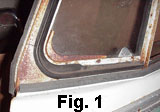
you look at is going to have rust somewhere.
Some types of rust are easy to remove and other types are so serious that they can make
a car virtually worthless. The least worrisome type of rust is "surface rust". Surface rust (see Fig. 1)
adheres to the surface, is a light orange/brown/red color, and has a texture like 100 grit sandpaper.
Surface rust is not serious, and can usually be easily removed by sanding or with rust removers like
Naval Jelly
(More Info).
Sometimes surface rust has slightly pitted the surface of the underlying metal, but this is usually not
a big deal since the pitted areas can be skimmed over with plastic filler (e.g., Bondo) and sanded smooth.
Surface rust is ugly but usually won't affect the value of the car or its restorability, too much.
Don't worry about surface rust.
The next type of rust you need to look for is "rust bubbles" (see Fig. 2). These are sneaky because
they live under
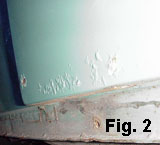
the paint and are often hard to see
from the outside.
Look closely at the edges of the body panels (like the bottom of the doors) for small bulges or bubbles
in the paint that look like a blister or scab on your arm. The bubble may be caused by
impurities or rust just under the paint or (worse) they may indicate a serious rust
problem that started on the other side of the metal panel and has finally gotten so bad
that it's reached the painted side of the panel.
If the seller allows you to, push gently on these bubbles (but not so hard that
you "crack the bubble" and ruin the paint) to see how "serious" they are.
If a bubble is pretty firm, the metal is
most likely not rusted through and you might be able to deal with the problem by grinding
the area down to bare metal and lightly filling with a product like "AllMetal". If the bubble is pretty spongy
you've got more work ahead of you because the bubble is probably just the "tip of a much larger iceberg"
of rust that goes all the way through to the backside of the panel.
In this case you're probably going to have to have
the diseased area cut out and a new patch panel welded in (expensive!).
The problem here is that you really won't know the seriousness of the problem until
you the get the car home and start sanding down the area. To aid in your pre-purchase diagnosis, try
to check out the back side of the panel, to see if it's rusted and flaky (bad).
The worst kind of rust is the cancerous rust that's been allowed to fester and spread for years
and
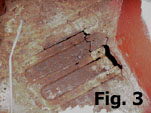
has actually dissolved part
of the metal, resulting in "pin holes" or larger areas that have been eaten away
(see Fig. 3).
Obviously, these rusted areas must be completely cut back to solid metal and a new
panel welded in. The good news is that several after-market suppliers have a good selection
of reasonably priced new patch panels for repairing the areas in a Vintage Volkswagen that
usually rust out. The bad news is that unless you're handy with a welder, having
the rusty metal cut out and replaced with a new patch panel can be a little pricy.
Look for Rust in a Classic VW Bus:
- Along the edges of the roof where it slopes down to meet the rain gutter
(especially on the passenger's side)
- The battery tray under the battery (on the passenger's side of the engine compartment)
Check the underside of this tray too,
by crawling under the bus
- In the cargo floor (lift up the rubber mat or carpet) along the edges,
especially behind the front seats (just behind the bulkhead wall)
and along the side cargo doors sill
- Along the bottom edges of the doors; especially the front cab doors
- In the front floor where the driver's feet rest and where the
passenger's feet rest. Lift the front floor mat to
check the floor and also look under the vehicle. This is a very common place
for a bus to rust and a likely location of rusted-through metal,
but replacement panels are available
- In the "dog legs" (the sloping part of the bottom of
the front door openings, above the wheel openings)
- In the curved rocker panel that runs all along the bottom of the bus, on both sides
- On the front of the bus just below the bottom edge of the
windshield rubber. Rust under this rubber seal
can also cause rust stains on the inside that run
down onto the dashboard or into the package tray beneath the dash
- On the nose of the bus just below the headlight trim rings
- On the nose of the bus, just above the small horizontal shelf
seam that runs across the nose, behind the
bumper. Also crawl under the bus and check the
valance panel that runs below this seam, behind the bumper
- On pickups, open the "tool box" doors and examine the lower storage area. Sometimes,
holes in the bed cause water to drip
into this storage area and rust out the floor
Look for Rust in a Classic VW Bug:
- Along the bottom edges of the doors
- Along the bottom edges of the front and rear quarter panels,
just above the running boards
- Just below the bottom of the windshield rubber.
- Just below the bottom of the rear window rubber. Leaks here can also run
down and cause rust on the shelf behind the back seat
- In the rear inner fender area. Look behind each rear tire, at
the bottom portion of the panel that the rear bumper brackets bolt to
- Just below the headlight trim rings
- Check the entire floor, especially the battery area (on the
passenger's side under the back seat)
and the heater channels that run under the car along each side of the car just
below the door sills. Raise the floor mats and also crawl
under the car and check the underside of the floor
8. Rust In A Vintage Volkswagen Bug
Busses don't seem to have this weakness, but on a bug, grab the rear bumper and pull it
gently up and down to see if it's loose. If it is, look underneath the car to see if the bumper bracket
bolts are just loose, or if they're bolted to rusted-out sheet metal instead.
9. Worn Out Clutch In A Vintage VW
A worn out clutch is common in an old VW, and is sometimes the reason the owner
is selling the car. To install a new clutch, the engine has to be removed from the vehicle,
and even though that sounds like a huge undertaking, in a VW it's a pretty straightforward procedure
that you could do yourself
or pay to have done for not too much money. If the vehicle has other things goin' for it
(like a nice paint job, or a straight and rust-free body) I definitely wouldn't let a tired clutch
scare me away. To see if the clutch is shot, park so there's nothing in front of you, set the parking
brake, depress the clutch pedal and start the engine. Shift into 3rd, give it a little gas and gently
let out the clutch. Then repeat the test with the transmission in 4th. The engine should
stall immediately, in 3rd and 4th gear, if the clutch is ok.
10. Test Driving The Classic VW For Sale
Drive the vehicle. If the shifter pops out of gear, you'll probably
need to get the transmission rebuilt or just live with it. If it's difficult to get the
transmission to shift into the next gear, the "syncros" in the transmission are probably shot
and you're looking at a rebuild to correct the shifting. If it's hard to
keep the vehicle going straight without constantly "correcting" the wheel,
you're going to need some front end work and possibly a rebuilt steering box (or maybe just
replacing the unevenly worn and under-inflated tires will fix the problem!).
If the brakes don't slow you down much, or they cause the vehicle to veer to
one side or they make a metallic grinding sound when you press down on the brake pedal,
for sure you're going to need a new brake job (that's not really that big
of a deal). If the rear end moans as you drive along, you'll need to have the transaxle
rebuilt to get rid of the noise.
11. Check The Accessories
Check the radio/stereo, try to roll the windows up and down. Does
the owner have keys for the door locks? Do the wipers work? Do the
headlights work? Does the sunroof open and close easily? Does the horn
work? Do the turn signals and brake lights work? Non-functional accessories like this aren't usually
a deal-breaker
but a vehicle with a lot of stuff not working, is a clue that the owner probably hasn't
taken very good care of this car. If you decide to buy the car, try to get the seller to knock several
hundred bucks off the selling price, to help you afford to get everything working.
12. Problems Getting The Vehicle Registered
Now the legal stuff. Check the registration tag on the rear license plate.
Hopefully it's in the current year or last year. If it's older than that, most likely
you'll
be stuck paying for the "expired registration" when you attempt to register the vehicle
in your name. In some states "bringing a car current" that hasn't been registered for several years is no
big deal, but in other states it can be costly (some states even charge extra
penalty fees
on a vehicle that's not been registered for several years!). Before you hand your hard-earned
bread over to the seller, make a call
to the Motor Vehicle Department, in
your State, to see how much it'll cost
to bring the registration up-to-date. Then negotiate with the seller to get him to pay
for all, or at least some, of the "expired registration" fees
(since he's the genius who decided to not register the car for the last 5 years!).
13. Does The Seller Really Own This Car?
When you call about the car, make sure the
seller has the "title" (some States call it the "Vehicle Certificate of Ownership"
or the "Certificate of Title of A Vehicle".
Californians call it a "pink slip").
If he starts making excuses about how "his dog ate it", then we've got a
problem. If he's telling the truth and he really
does own the car but has lost the title, this
will be a hassle, but it's not the end of the world.
He will need to go down to the Department
of Motor Vehicles and fill out some forms that will show that he really is the owner, and you'll
then use this form (sometimes called an "Affidavit In Lieu Of Title")
when you transfer the vehicle's ownership from the seller, to you.
But if he's
not willing to help obtain these forms, I'd say there's a pretty good chance
he doesn't really own the car (this doesn't mean he actually
stole the car - maybe it's
his ex-wife's car and he doesn't think it's a big deal that he's selling the car and pocketing the cash
without telling her!). Buying a car with no title is not at all smart because you'll usually have
a steaming heap of trouble convincing the Dept. Of Motor Vehicles to transfer ownership of the
the car to you, and issue a new title in your name. As with most things legal, the degree of
difficulty varies from state to state, so before you even consider buying a car with no title,
write down the license number and VIN and do some research with the Dept. of Motor Vehicles to
see what it will take to make
this car "legal". Remember,
what you're really buying here is
a
title, not a car, because whoever holds the title, owns the car - no matter who got tricked
into "paying for it".
14. Buying A Car With No Title
Now let's say you decide to buy a car that comes with "No Title". This could
be a stolen vehicle, but not necessarily. It may be an old car that's been sitting behind a barn
or in a wrecking yard for years and the title is long gone and the current "owner" knows nothing about the
previous owners or the title. Write down the license plate number and the VIN and head down to the
Department Of Motor Vehicles and have them research the vehicle on their computer.
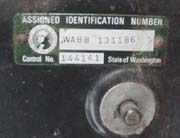
This is a sketchy situation, but if they can't find any record of the vehicle in their files,
and you
really want this car, you can buy it and apply for a new title in your name.
Basically, the State Highway Patrol will assign a new VIN to the car and rivet a new metal VIN tag
(see photo on the right) to the driver's side door jamb. Then you fill out some forms at the
Department Of Motor Vehicles and they'll issue an "Affidavit" (not a
Title) that states that
you have applied for a new title under the new VIN. Now you wait for 3 years. During this time period, the
"real" owner may surface and claim the vehicle, in which case you lose the car and any money
you paid for it, so there is some risk here.
But at the end of the 3 year period, if no one has come forward to claim the
vehicle, the DMV will finally issue a new title in your name, under the new VIN. Note that you
shouldn't make any plans to try to sell the car during this 3 year period. Most people won't
want to risk their money on a car who's ownership is in "limbo" like this. And you should also be
aware that selling this car to an
out-of-state buyer will be virtually impossible because the
buyer's DMV won't honor your State's Affidavit and "waiting period" legalities. So if the car
you're looking at already has an "Assigned Identification Number" tag, make sure the VIN on this
tag matches the VIN on the Title, write down all the numbers and check with your DMV to make sure
everything is legit. If the seller doesn't have the new title yet, find out from the DMV when this
vehicle's waiting period will be over.
15. Does The Title Match This Car?
Now, assuming that the seller has the "title" document, you need to check it to
make sure that it really belongs to the Volkswagen that's for sale. So grab the title and
study it carefully. The address may not match the seller's address, because he could have moved.
The name may not match the seller because maybe the son is handling the transaction for his
ailing mother, or maybe the gal who's selling the car got married and has a new last name now.
The license number
may not match the plates on the car, because some states like to issue a new set of license
plates every 6 or 7 years and they don't issue an updated title when they do this. But the
description on the title should be close to what's sitting in front of you with the "For Sale"
sign in the window. Obviously the title should say VW or VOLKSWAGEN or VOLKSWAGON. If you're looking at
a Bug, the title may say BUG or SEDAN or TYPE-I or TYPE-1. If it's a bus, the title should say something
like BUS or VAN or KOMBI or TRANSPORTER or TYPE-II or TYPE-2. The "Year" is a little tricky.
The seller may be advertising it as a "1965 Bug" and hopefully the title shows a year of "1965".
But, since the new models usually began production in the previous August, this 1965 Bug may have
actually been manufactured in Germany in September 1964, shipped to the United States and then registered
in November 1964, so the title may show a "Mfg Year" of 1964 instead of 1965.
When the title is showing a different year than what the seller is claiming the vehicle to be,
you should at least start checking the features on the car so you know what's really being sold.
For example, there are a lot of differences between a 1965 bug and a 1966 bug, so if the seller
insists it's a '66, make sure it's got the center defroster vent on the top of the dash, etc.
In other words - do your homework so you know what you're really buying. I'd be very
suspicious if the year on the title is
greater than what the vehicle appears to be.
16. Buying A Car With A Salvage Title
If you see an 'S' or 'SALVAGE' printed on the title, this is a "salvaged" vehicle. This means
that at some point in the past, this car suffered a major trauma; like it caught fire, sank
to the bottom of a lake, was caught in a flood (think "Katrina" or "Super Storm Sandy")
or was involved in a horrific accident. In these circumstances, the
Insurance Company decided that the vehicle was not worth fixing, so they took the terminally
damaged car from the owner and paid him "fair market value" for it (yeah, right) so he
could theoretically buy a replacement car. At this point, the wreck is usually hauled off to the
junk yard, but sometimes the Insurance Company decides they can make more money by selling
it to an Auto Body shop or hobbist who wants to tackle the repairs and put it back
on the road. When the Insurance Company sells a "totaled" vehicle like this, the State will
issue a new title document marked with an 'S' or 'SALVAGE' so from that point forward, everyone
will know that this vehicle was declared "totaled", but was then brought back from the dead. Buying a
"salvaged" vehicle can be good, and it can be bad. On the plus side, the seller won't be
able to ask as much for the vehicle so you'll usually be able to get a pretty good deal. The
down side is that obviously you're buying a vehicle that has had some major damage and maybe it wasn't
fixed as thoroughly or as professionally as the seller claims. It could be a great
car, but remember that if you ever decide to sell it, potential buyers will try to knock your price
down because it's a "salvaged" vehicle.
17. Is This a Stolen Volkswagen?
For a lot of reasons, old Volkswagens seem to be especially prone
to being stolen and resold with a false title. When looking at a used VW, you need to be
aware of this so you don't mistakenly buy a "hot" VW. Here's the way a thief pulls off this crime;
first he steals a clean VW and removes it's ID plate and license plates. Then he buys
a wrecked VW (that comes with a "clear" title document), from a friend or from a junkyard.
Next he prys the ID plate off the wrecked vehicle and attaches it to the stolen vehicle
(with pop-rivets, or screws, etc.).
Then he moves the license plates from the wreck, to the stolen VW, and now the stolen VW has
new license plates, a new ID plate, and a matching title. The stolen VW now has a completely new
identity with a "legal" title to match. But if you buy this vehicle, and then someone recognizes
it and calls the police, you'll lose the vehicle and may be arrested for "receiving stolen goods".
So now that you're aware of the problem, here's how to avoid being suckered in by this scam:
First check the year and description on the title, to make sure they match the vehicle being sold.
As we mentioned earlier, it can be legitimate for the title to show a year that's one year earlier
than the vehicle (e.g., a 1967 bug, but
the title shows a year of '1966'). Anytime the year on the title doesn't match the vehicle being
sold, especially if the year on the title is
greater than what the vehicle obviously is, you need to
be suspicious and do more research on this vehicle.
But the most important thing is that the Vehicle ID (also
known as the VIN, Identification number or Chassis Number) stamped on the vehicle, matches
the number printed on the title.
Finding The VIN On a Vintage Volkswagen Bug:
The VIN is found in 2 places; stamped into a metal plate that's pop-riveted onto
the body in the
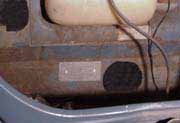
trunk area, behind the spare tire (the light gray rectangle in the middle of the photo on the right),
and stamped directly into the frame, under the back seat. The
ID plate behind the spare should have the correct VIN, but that doesn't prove much since this plate
is easy to move from one vehicle to another. The number stamped into the frame is much more important
because it's very difficult to convincingly alter this number.
Raise the front edge of the back seat bottom cushion and towards the back of the floor you'll
see an oval shaped black metal plate on top of the transmission hump.
Once you unscrew this cover, you should see the Vehicle ID Number stamped into a flat area on the
frame. It might be greasy or dusty so wipe it off. If the number is gone,
or it's been "filled", covered up or altered in any way or the seller tries to keep you from
checking this number, or it just plain doesn't match the VIN on the title, walk away from this vehicle
because it's almost certain that it's been stolen. The bottom-line here is that on a bug, the VIN
stamped under the back seat and stamped onto the ID plate in the trunk
must match the VIN printed on the title document.
Finding The VIN On a Vintage Volkswagen Bus:
On a Bus, the VIN can be found in 3 different places;
on the Chassis Plate, on the M-Code plate and stamped into the body. Originally, the Chassis plate was
attached
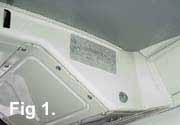
to the bulkhead panel behind the engine, on the passenger side (see red outline in Fig. 5 below;
this plate should be plain aluminum, not painted), but starting in Nov. 1963,
Volkswagen moved this plate and pop-riveted it to the passenger's side of the ceiling air vent
in the front cab area
(this plate should also be plain aluminum, not painted over; see Fig 1).
The VIN is stamped into this plate with a 2-digit prefix number that identifies
the body type (e.g., 23 = Kombi, 24 or 25 = Microbus, 26 = Pickup...). Starting in October 1958,
Volkswagen attached an "M-Code plate" to the panel behind the front passenger's seat
(Fig 2. shows a walk-thru model and Fig 3. shows a bulkhead model) with
2 small round-head screws (this plate was attached before the bus was painted, so
it,
and the 2 screws,
should all be painted the same color as the surrounding metal).
The M-code plate indicates the original colors
and special options that the bus originally came with
(More Info), and it also
contains the VIN, without the 2-digit prefix.
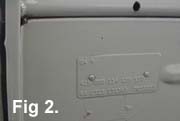
The Chassis plate and the M-Code plate are important, and hopefully
they are stamped with the same VIN as the one shown on the title, but plates can be moved from vehicle to
vehicle, so the most important number for confirming a bus' true identity is the VIN stamped
directly into the body. Look for this number stamped into the sheet metal surrounding the passenger's side
of the engine, (the area circled in red in Fig 4.) right next to the sheet metal screw
that attaches the
rear apron. This stamped number is often obscured by grease,
and since it's near the battery,
it may be a little rusty and corroded. Wipe the area with a rag to see the numbers more clearly.
If you still can't make out all the digits in this stamped number, dip the rag in some paint thinner, or
rub lightly with steel wool (with the owner's permission of course!). The VIN on
the Chassis Plate and stamped next to the engine will begin with the 2-digit body type prefix
(e.g, 23 = Kombi,
24 or 25 = Microbus...) and this is usually the number you'll find printed on the title. The VIN on
the M-Code plate does
not include the 2-digit body type prefix so take this into account when
comparing this VIN to the one printed on the title.
If the number stamped next to the engine doesn't match the VIN on the title,
or it's been filed away or obscured, or the metal has been cut out, or a piece of metal has
been welded over it, it's most likely
a stolen vehicle, so walk away from the deal!
|
18. The Seller Signs The Title To Transfer Ownership
Ok, so you've decided to buy this classic VW.
By now, you've had a lot of time
to look over the title and now it's time to have the seller sign this title over to you.
Title document formats vary from State to State, but they all have one space for the "Legal Owner"
and another space for the "Registered Owner". When you buy a new car and finance the purchase
with a loan, the Bank or Credit Union who granted you the loan will appear on the title as the
"Legal Owner", and your name will appear as the "Registered Owner". When you pay cash for a car,
there's
no lender involved so your name will appear as the "Legal Owner" and the words "same as legal owner"
will usually be printed in the "Registered Owner" space. You're buying a 40 year old vehicle, so
it's very unlikely that the seller got a loan to buy it, so all you need to worry about is the
seller's name which should be printed in the "Legal Owner" section. To "release" their ownership,
the seller(s) will need to sign the "Legal Owner" part of the title. Remember that every person
listed on the title as an "owner" (e.g., husband & wife, or Father & son, etc.) must sign and date
the title. If the title shows that the vehicle is owned by a company (e.g., "Harry's Restorations"),
a company representative will need to sign and date the title. If the title shows a company and
an individual (e.g., "Harry Pitts", "Harry's Restorations"), both the individual and a
company representative will need to sign and date the title.
19. Transferring The Title Into Your Name
Take the signed-off title to the Department of Motor Vehicles
(sometimes called the DMV or Licensing Department). Bring your checkbook to pay the necessary
fees to transfer ownership of the vehicle into your name. Some States will also charge you
sales tax on the purchase price. One final tip; if the lines are long at your local DMV office,
try your Automobile Club (AAA) office. You'll need to be an Automobile Club member (not a bad idea
when you're driving around in an antique car that may need to be towed or flat-bedded
now and then!), but they're usually very helpful (especially with complicated transactions) and the lines
are usually very short. Note that the Licensing Department may also require that you provide them
with the verified
weight of your vehicle, if this weight is not already printed on the old title. If the
vehicle runs, drive to the local city dump, landfill or "transfer station" and for a small fee
they'll let you drive onto their big scale and will then print out a slip showing your vehicle's weight.
Or alternatively, check out our
table of Volkswagen Weights and Dimensions
and lookup your vehicle's weight and print a copy of the screen for the DMV.
Here are some close-up photos of typical rust on a transporter;
beneath the windshield rubber, rocker panel, rain gutter at the back of the bus, and
rain gutter at the front (click on an image to enlarge it):
|
|